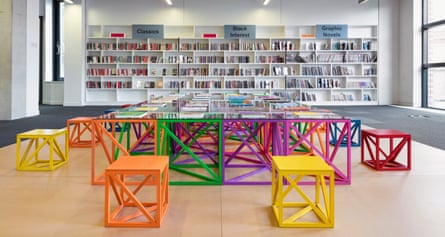Blood splatters, soul soda and a giant George Michael: inside Brent's biennial
From a pandemic memorial to stackable cubes and an epic mural of the Wham! star, small and inviting exhibitions keep the focus local in this inaugural festival
Biennial reviews often start with descriptions of the perilous journey the critic has undertaken to reach this far-flung spot, with tales of rickety aeroplanes, crumbling mountain passes and venomous insects. But for this, all I had to do was clip the dog on a lead, walk down the road and turn left.
Brent doesn’t just have an art biennial now, though. The London borough is also this year’s borough of culture (or “borough of cultures” as they prefer it). It has been tricky for anything to go ahead as planned, though, meaning the biennial is a hybrid online/offline affair, with real-life art at outdoor sites and in local libraries.
The pandemic has hit Brent hard. For Ruth Beale’s Library as Memorial, 491 volumes in Kilburn Library have been given an “In Memoriam” bookplate. Each can be dedicated to one of the borough residents who have died of Covid-19. After the biennial, the books will go back into circulation and carry their personal memorial with them. It is a quiet, intimate work.
Imran Qureshi’s And They Still Seek the Traces of Blood, by contrast, is an explosive presence in Ealing Road Library. Huge snaking sheets of crumpled paper apparently spattered and stained in blood are suspended from the ceiling, above a couple of the Lahore-based artist’s gilded miniature paintings. A glass box holds thousands more sheets, printed with faint purple images of stylised plants, and splattered in blood-like paint. This, too, is a memorial – albeit a furious one: the traces of turbulent attack seeping through paper in this habitually silent and reverent space.
In less touch-averse times, Qureshi’s crumpled sheets would be a knee-deep installation that visitors could walk through. Certainly, wading through the inescapable traces of violence would have pushed the work’s theme harder.

Rasheed Araeen, the biennial’s other headliner, has also installed a work that requires interaction: sanitised handling is permitted. The artist’s stackable coloured cubes, Zero to Infinity, are at Willesden Library as part of a pleasingly extensive display. Araeen, whose studio is nearby, is honoured as founder of the important journal Third Text, as an engineer of conceptual “happenings” and, more recently, as a painter exploring philosophical and calligraphic traditions.
A number of bright, geometric paintings derived from philosophical texts are presented with working studies. Explicitly derived from Arabic thought and visual cultures, the paintings expand on the artist’s long-held advocacy for an understanding of modernism that looks beyond Europe and the US.
Public artworks include Dawn Mellor’s fan art mural dedicated to George Michael near his teenage home in Kingsbury. Dan Mitchell has transformed the facade of Wembley Library with a text work that echoes the promotional signage ubiquitous in the area. A JG Ballard quote – “These days even reality has to look artificial” – is spelled in tall vinyl lettering clipped from stock imagery: blandly attractive people engaged in blandly aspirational activities – oh and Paolo Uccello’s St George and the Dragon, presumably as a reference to the heroic British self-image. It apes the graphics adorning the surrounding developments with such devastating accuracy that one might easily miss it.
Public artworks include Dawn Mellor’s fan art mural dedicated to George Michael near his teenage home in Kingsbury. Dan Mitchell has transformed the facade of Wembley Library with a text work that echoes the promotional signage ubiquitous in the area. A JG Ballard quote – “These days even reality has to look artificial” – is spelled in tall vinyl lettering clipped from stock imagery: blandly attractive people engaged in blandly aspirational activities – oh and Paolo Uccello’s St George and the Dragon, presumably as a reference to the heroic British self-image. It apes the graphics adorning the surrounding developments with such devastating accuracy that one might easily miss it.
Highlights of the online programme include Jude Wacks’s Instagram exhibition affectionately profiling family businesses. First up is John Gibbons, the greengrocer who has plied his trade outside Dollis Hill station for 43 years. Next month the October Anthropologist team will present their artful study of highly educated European immigrants working as baristas in Brent’s hipster coffee joints.
In pre-Covid times, art biennials, triennials, quadrennials, quinquennials and their ilk proliferated globally. You could spend your life travelling to them. Many critics and curators did. Which was fun and glamorous (if unsustainable) but posed the question of who those far-flung art events were actually programmed for: the international crowd on a two-night visit, or local residents?
For the first time, I’m a native rather than a blow-in. And this biennial is unusually local in focus, with workshops and community projects central to the programming, and exhibitions small and inviting. Walking home, I popped into a favourite local restaurant, Ariana II, for a bottle of Abbas Zahedi’s Soul Refresher – a delicious spicy pink soda produced for the biennial, and distributed largely through a food bank the artist founded in Neasden.
Around the corner, I bumped into artist Pio Abad working on the first of his two murals for the biennial. He’ll be there for the next four weeks. Having an artist at work and ready for a chat in the neighbourhood is a simple but powerful way to make art inviting and accessible. Frida Kahlo’s introduction to painting, after all, was watching the Mexican muralists at work in her high school. What a privilege to be able to follow this piece’s progress.


No comments:
Post a Comment